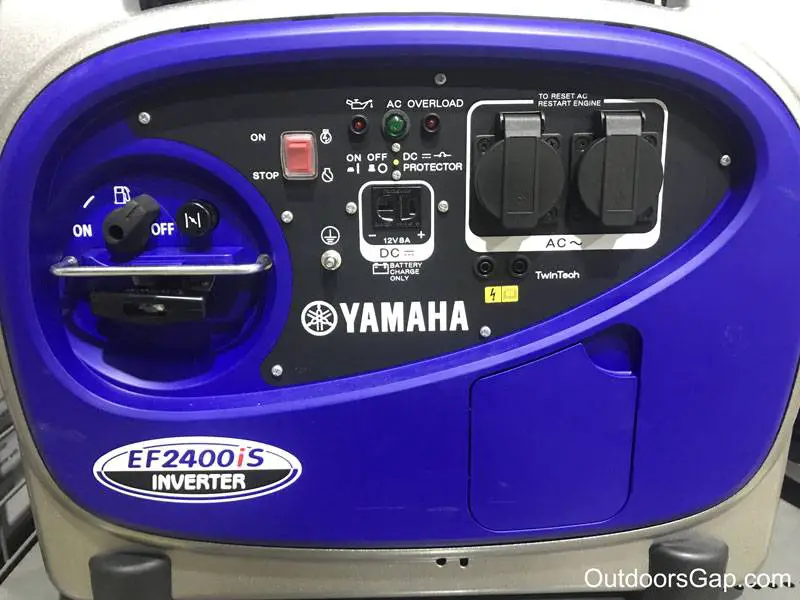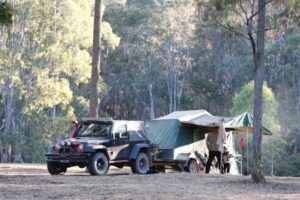
Camping in the Australian bush is a lot of fun, but sometimes it can be harder than it needs to be. So we have put together some camping tips, which are not only handy for the tent camper, but also for the caravanner and fisherman who likes getting outdoors.
Here are over thirty camping tips for Australia:
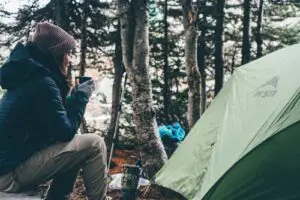
Take a tarp.
A tarp is one of the top ten best items you could take into the bush.
You can use the tarp for multiple uses like:
Fly it off the main tent and you have extra shade and shelter. This is a good area for keeping the camping chairs under and a food prep area.
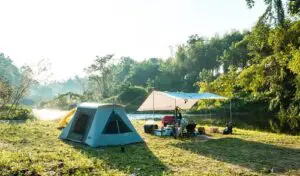
Also if it is raining being stuck in a small tent is no fun, so having room outside, but undercover will keep you sain.
Collect rain water.
Stop the wind.
Place the tarp over the main tent if the tent leaks.
Place the tarp under the tent, so the tent floor doesn’t get wet and you can pack the tent up quickly. It is easier to dry out the tarp, rather than the whole tent.
Cover over firewood so it doesn’t get wet.
Frozen ice for camping.
Rather than buy expensive bags of ice, fill plastic water bottles up and put them in the freezer. You not only have ice, but also cold drinks and spare water when they thaw out.
(Don’t fill the water bottle all the way up as the ice will expand in the bottle.)
A bag of frozen vegetables also can double up for ice and add some veggies to a camping meal.
Tent stakes.
If you forget the hammer, use the back of a hatchet to hammer the tent stakes in.
(Safely of course with the sheath / cover on the hatchet or axe. Obviously don’t swing the hatchet backwards towards you when hammering the peg in.)
A thick branch a couple feet long, around wrist or arm thickness, also makes a good improvised hammer.
Hammer the tent peg in at 15 degrees to around 45 degrees to the ground. If the stake is just hammered into the ground vertically 90 degrees, then winds rocking the tent backwards and forwards can loosen and pull the tent peg out.
If the ground is too hard or rocky to hammer stakes in the ground, then tie guy ropes to logs, tree stumps or rocks. You can loop the guy ropes around them.
For sandy conditions a Deadman’s anchor can be used. Bury a thick stick sideways in the sand with the guy rope attached to it. A rock can also be used to bury.
You can also fill up a bag or dry bag with sand and attach a guy rope to it for an anchor point.
The pop up tent.
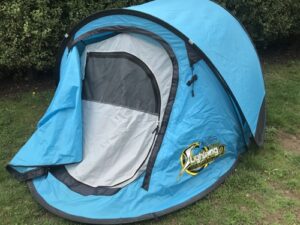
To save time camping choose a pop up tent.
If size isn’t a main concern, then check out the advantages of a pop up which can literally be set up in seconds. They are limited in room size and head height but are fantastic for a quick set up. Click on Pop Up Tents for more information about what one is, the negatives and positives, and the best pop up tents in Australia.
(This article also explains the difference between a pop up tent and an instant tent.)
For more room in a tent, but you still want a quick set up time, instant tents are worth checking out. These tents allow greater head room and come in a variety of sizes, like 4 person tent, 6 person, all the way up to 12 person tent.
Don’t leave boots outside.
Don’t leave shoes and outside of the tent or swag overnight. Not only will the dew make them damp, but poisonous spiders, scorpions, centipedes and other insects can get inside them.
Put the boots in a dry bag if you haven’t got room inside the swag. Or just put them inside the tent with you.
Camp in the back yard.
If the children haven’t been camping before, sometimes it is good to introduce them to the tent, sleeping bag, etc., with a camp first in the back yard.
This helps them get used to the camping gear and atmosphere.
Forgot your camping pillow?
If you forget your pillow, use a rolled up jacket. Stuff it inside a jumper. Some campers tie the ends so the filling doesn’t get squashed out when sleeping on it.
Or use the sleeping bag cover for a pillow case to stuff clothes in it. If the fabric feels awful, cover over it with a soft t-shirt.
For hikers and backpackers, the soft back insert taken out of a backpack, or the actual back pack itself can be used as a pillow.
A dry bag blown up (or fill with clothes) can work as a makeshift camping pillow. If the plastic feels bad for a pillow, throw a jumper around it for softness.
Back up lighter or matches to start a campfire.
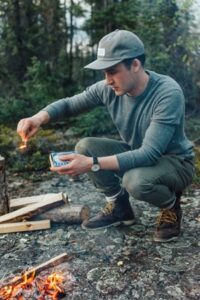
Take an extra Bic lighter, matches or a ferrocerium rod when camping. In case you lose your main method of lighting a campfire. An extra lighter in your glove box, back pack, caravan or tackle box is a good idea for a backup.
Place the lighter and matches in a waterproof snap lock bag with some fire tinder’s for emergencies.
Safety with campfires.
With the recent Australian bushfires, most people realise the power and devastation of an out of control fire in the bush.
So a campfire needs a lot of respect and attention so it doesn’t get out of control.
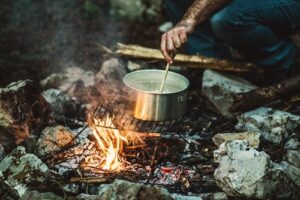
If it is safe to have a campfire and allowed, clear a large area around it.
Clear the area free of leaf litter, foliage and sticks. Remember that underground tree roots can burn, so be careful that you don’t prepare the campfire to close to trees.
Have a shovel handy and water close by to help control the fire.
Never make the fire bigger than needed as it can get out of control. Most Aussie campers have their campfire too big.
A camp fire is a great tool to have when camping as it provides many advantages. Like: warmth, light, a way to cook food and is great entertainment watching the fire as the bush TV. But having a campfire is a privilege, not a right. So be camp fire safe.
Don’t have a campfire on a hot, windy day.
Douse the cold coals with water to make sure they are out. Always triple check the campfire is out before you leave the camp site.
Carry extra water.
A spare jerry can full of water or two is very handy to have. Especially if you are in hot places camping or fishing.
It is amazing how much water you go through camping, such as: preparing food, camping hygiene, washing dishes, not to mention using it for cups of coffee.
The old saying that you can only live around three days without water is very true, but in very hot places like the Northern Territory or parts of Western Australia or Queensland, it could be just a day or two if you exert yourself like backpacking or setting up camp. So water is essential and you need a lot of water in hot environments.
Having extra water is important if you decide to stay longer camping at a nice place. Or perhaps you might get lost or bogged down for a day or two in the outback. Either way extra water is vital.
Have a shovel.
A shovel when camping, or travelling in a caravan is a good idea as it is so valuable.
It can be used for helping dig out vehicles from a bog, to moving coals around on a campfire for cooking, or using the shovel for preparing the Aussie bush toilet. (Digging a hole.)
Sweeping the tent.
Have a half brush and shovel, to clean out the tent floor, or to brush down the tent down when packing up. (If you pack up the tent with vegetation in it, the tent material can rot.)
If you don’t have a half brush and shovel, make a broom with some bracken fern. Use a bit of cardboard as a shovel. Angle the cardboard ten degrees or so and sweep the mess onto the card board.
Start from the back of the tent and sweep towards the entrance. This reduces the dust for the person sweeping and is easier to sweep it out the tent.
Air the tent during the day.
Open up the tent window flaps and allow some airflow during the day.
Even well designed quality tents can get condensation, so air them out.
Take rope and Paracord.
Extra rope and paracord is handy when camping. Paracord is ideal for attaching items and setting up things like tarps, etc.
Take some pegs and hang the clothes of the tent guy lines to dry. Or for the bushcrafter, make some out of sticks.
If you have a bit of washing to dry, tie some paracord from tree to tree and you have a clothesline.
Be careful where you set up the tent.
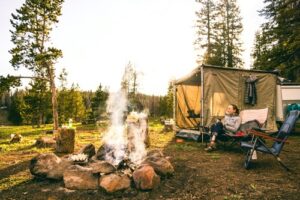
Don’t set up in dry riverbeds as they can flash flood.
When setting up the tent, don’t set it up in a depression as if it rains, the tent can get flooded.
Don’t set up too close right near a lake or river. If the water rises you can get flooded out.
Also too close to water and the mosquitos will be worse. Also you might be stopping wildlife like kangaroos, or livestock from coming into a waterhole to drink.
In warm weather snakes like hunting around dams, lakes and rivers in search for frogs, so setting up too close and you might get some snakes at your tent door.
Before you place the tent down, move any sharp sticks or rocks. As they can tear or poke a hole in the tent floor.
Avoid areas where bull ants and ant’s nests are.
A dangerous place to set up a tent is under or near dead trees and widow makers. (Large dead limbs that may fall.) Campers die every year by camping too close to rotted or dead trees that fall down.
Some tree are more susceptible to falling than others. Wood grubs, strong winds and rot can damage the trees and unfortunately sometimes you cannot tell what tree is damaged, so it is best camping to camp safely away from trees if you can.
How to pull tent stakes easily out of the ground.
Use another tent peg to help pull out another peg. This also saves you bending down a lot.
If the peg is angled in the ground at 45 degrees, don’t try and pull the peg straight up and down. Pull the peg out the same 45 degree angle.
(It is amazing how many times I see new campers trying to pull the tent stake out at 90 degrees to the ground, when the peg is hammered in on an angle.)
A loop of thick rope or paracord can be used (or use a wooden toggle with a rope loop) to help pull the pegs out.
If the tent stake is hard in the ground, use a long stake or strong branch to help lever it out. Put it to the one side underneath the stake angled on the ground, the other side of the long stick or stake can be pulled up. This will help leverage the tent stake out.
For last resort methods, sometimes pouring water around the stakes can make them easier to come out, but it can waste water. Wiggle them around rotating them to get them out. Digging the tent stake out is another method.
How to set the base of the tent out.
Peg out the tent diagonally across first. This will stretch the tent out the best, so the floor isn’t lop sided and crinkled. Once you have pegged out diagonally opposite then you can do the other corners and stretch them out evenly.
With most tents you are better off pegging out the floor first, before you start threading poles through the sleeves. This way the tent doesn’t catch the wind and flap about when doing the tent poles.
The wee bottle.
For the older campers, or people with injuries getting up during the middle and going to the bush toilet can be hard work. So having a wee bottle close by the sleeping bag is handy.
Use an old Gatorade bottle or similar empty bottle. Obviously remember too screw up the cap tight in case it gets knocked over.
For winter camping, the wee bottle keeps you in the warmer tent and out in the cold.
For summer camping it stops you unzipping the tent and allowing the mosquitos to get in.
Also on hot nights you have a lot of or annoying insects and spiders crawling about. So walking around the campsite at night while you are half asleep trying to find a wee spot can be painful.
The wee bottle is also ideal for sleeping in the roof top tents that goes on top of vehicles. As getting up and down the ladder can be dangerous when sleepy.
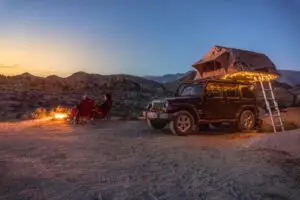
LIFO (Last in first out.) packing.
When packing camping items in the vehicle remember the last in, first out motto.
Camping chairs are good to put in last (if they aren’t too heavy on items) as they can be the first thing to get out. You can sit other items on them while unpacking the vehicle. It save putting items on the dirty ground when unpacking.
The tent is another item that should nearly go in last as you can set it up and then unpack the rest of the vehicle, like clothes bags and bedding straight into the tent. If you have to get everything out first before the tent, you may not have anywhere to sit the items. Placing them on the ground isn’t ideal as bull ants and insects can get into the bedding.
The LIFO method of packing for camping is worth remembering as there is nothing worse than unpacking the car at one o’clock in the morning, trying to get the tent out and it is raining.
A tarp is a good idea to put items when you unpack, however to save double handling camping gear, throw them straight into the tent.
Take a first aid kit.
For safe camping, bring along a first aid kit. As well as the normal Band-Aids, medication and antiseptic, three wide snake bite compression bandages are valuable items to take.
To keep up to date with the latest first aid course and procedures, do an accredited course with a provider like St Johns Ambulance.
Get a bigger tent bag.
If you camp a lot, a lot of time is wasted trying to pack a big tent into a small tent carry bag. So it might pay to buy one or get a bigger tent bag made.
It not only saves time but a lot of frustration. Also you might end up ripping the tent fabric trying to squash the tent into a small bag.
A lot of Kings camping gear like their double swag carry bag is oversize which is great for easily packing items up. I believe also Oztent has some great oversize tent bags with extra room.
Camping torch tips.
A headlamp is great for camping, as it keeps your hands free for doing things. A headlamp is also ideal for night fishing.
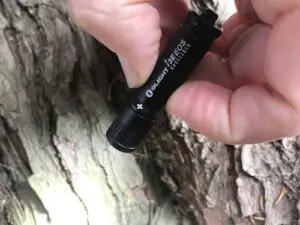
For outdoor campers or fisherman who do like using the handheld torch, a powerful little light like the Olight i3E EOS flashlight, or the i3T EOS from Olight Australia are fantastic. They are reliable, strong and very bright for their size. Read my review, buy clicking on Olight i3E EOS review or visit the store at Olight Torch to check out the latest price on one. (Affiliate link.)
These torches are great for the kids as well when camping. Or for a backup torch.
If you like holding the little flashlights in your mouth while using your hands, place a wrap or two of electrical tape over the end of the torch, so you don’t get the cold metal taste.
Regardless if you are camping or fishing, or caravanning around Australia, have a back-up torch handy for emergencies.
Another tip that is used by the military is putting a red filter over your flashlight. As it can help save your night vision while reading maps or setting up camp in the dark.
If your torch hasn’t go the option of a filter, you can place some red cellophane and an elastic band over the end on the torch or a red balloon for a red light.
Air the sleeping bags out.
If you are camping for a few nights straight, hang out the sleeping bags to air. Set up some Paracord from a tree and hang them out.
Don’t let them touch the ground as dirt and insects can get on the bag.
Remember to shake them and check they have no bull ants on them before you put them back into the tent.
Don’t place items on the tent wall.
Don’t put items near tent walls as the damp from the outside or rain can soak through the material and onto the inside.
Ensure the bedding doesn’t touch the tent side or you leave your clothing bag on the walls. Allow a few centimetres of room between gear and the tent walls.
Extra camping meals.
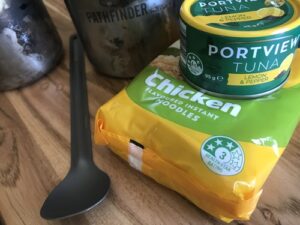
Always have a spare tin baked beans, tinned tuna and two minute noodles in the camping pantry or tub in case you stay longer.
An extra meal or two as a backup is a great idea, especially if you have hungry kids who eat everything in sight.
Items such as instant oats, long life milk, peanut butter, dry biscuits, beef jerky, instant rice and of course tinned spam are good backups.
Nutri-Grain is handy as you can have it for cereal, or just eat it plain for a snack. You can add it to trial mix for a nice snack.
Packet soups are great for camping and only require some boiling water. Chicken noodle soup is popular for the family. Add some vegetables to it for a healthier meal.
For winter camping, the Dutch Curry Soup is hearty and warming.
A block of fruit and nut chocolate always seems to go well when camping. Hot chocolate or Milo go well with the chocolate as well.
Wraps / pita breads can last longer than breads and are versatile with what you can use them for. They can be used with and egg omelette, cold salad wraps or used with some peanut butter. Wraps are good for mopping up the left overs of a camping stew as well.
At the moment my kids are enoying hot dogs in a can. Yes, probably not healthy, but they are quick and convenient to heat up for a meal. You can boil them up (also in the tin, with the lid open) or cook them on a BBQ plate. A bit of dead horse (tomato sauce) and some bread and it goes well when camping. For the more adventurous, onions and mustard taste great with them.
Have a camping checklist.
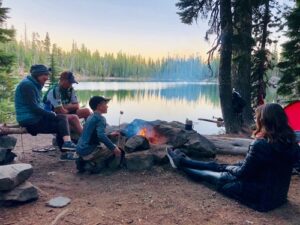
It can be stressful when packing to go camping, fishing or caravanning. So a checklist is a great idea, as it is so easy to forget items, like the toilet paper or fishing bait. (I wonder if I could accidentally leave a child home?)
If you are just going close by camping or fishing for the weekend, then the camping checklist might be a basic one.
You might have a very detailed checklist that you have planned if you are doing a caravanning trip around Australia for a year.
One of my camping buddies has a plastic covered, typed out checklist. Each time he goes camping, he can write on in with a whiteboard maker and tick the items off. He then can wipe it off and re use it again.
I just grab a bit off paper and write things down for the checklist.
For the tech savvy fisherman and campers you can record it in your phone notes or even get camping apps with a checklist.
Extra warmth in the sleeping bag during winter camping.
Sometimes our trusty old sleeping bag doesn’t keep us warm enough when camping, so these camping tips will keep us cosier on the cold nights.
Thermal underwear is a good choice for extra warmth when camping in cold places or the winter.
I always have a fleece jumper and jacket close by my sleeping bag in the tent. So if the temperature really drops down, I can put on some extra clothing to keep warm through the night.
If you have plenty of room in your sleeping bag and you know it is going to be chilly in the morning, place your clothes in the bag with you. That way your clothes are warm to put on the morning.
Sleeping bag liners, like the Sea to Summit Thermolite Reactor Extreme Sleeping Bag Liner can get some extra degrees of comfort and warmth.. Click on Thermolite Sleeping bag liner for the latest price from Tentworld. (Affiliate link.) Liners are a good way of protecting your bag as well, as they are easier to wash than the whole sleeping bag.
This tip will help keep warm during winter camping, wear a beanie, gloves and a long thick pair of woollen socks. A scarf or a Shemagh also helps retain the warmth around the neck area and shoulders. Combine these items with a set of thermal underwear and it can really help keep you warmer at night.
Upgrade to a new sleeping bag. While sleeping bags can be expensive, sometimes for winter camping or cold environments a new bag is the way to go. If you look after it, the sleeping bag can last for many years and will keep you warm.
If you don’t have the funds for a high tech new space aged material sleeping bag, then look around for some second hand army sleeping bags. I have an English army winter sleeping bag that is warm enough for me when camping in the cold Victorian bush or fishing in Tasmania. It is bulky and big, but gee it is cosy and warm. Aussie Disposals and some camping or military surplus stores can have some great bargains on camping gear and sleeping bags sales.
Spare socks for hikers
This tip is from the military, alternate the pairs of socks when hiking. One pair is on your feet, and if the weather was fine, the other pair is tied on the backpack.
This allowed the spare pair to dry and air when you are walking.
When you set up camp, you then change into the fresh pair. The next day, you then tie the other pair of socks on the pack to air. This is a great way to alternate socks and keep them fresh and not wear sweaty smelly socks for several days straight.
Bad mosquitos.
If the mosquitos are bad around the tent at night, give the tent entrance a light spray with insect repellent about an hour before bed. Of course don’t spray directly on the tent fabric, as chemicals can damage it. Also don’t use too much spray as the tent will be smelly.
But a light spray can stop the mossies hanging about and getting in the tent when you unzip the tent.
Clean up your rubbish and take it home.
A lot of fishing spots, camping spots, parks and farmers properties are closed to camping now, because of rubbish left by idiots.
Left over beer cans, broken glass and rubbish everywhere isn’t a good look in the bush.
So if you take food packaging and items with you camping, do the right thing and take the rubbish home with you. It isn’t that hard.
If we don’t look after the bush, all the fishing spots, camping spots will be banned and we will have to pay money to go in a state or national park. That is if they don’t close it down, because people leave rubbish.
Zip the tent up.
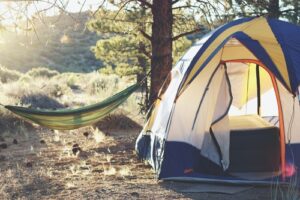
Creepy crawlies like centipedes, spiders, scorpions and mosquitoes are notorious for crawling around in the Aussie bush, so make sure you zip the tent up at all times.
Even during the day, zip the tent closed, as bull ants can crawl up tents and have a knack of getting in your tent.
The children love to rush in the tent and out again to grab something and forget to zip the tent up. Perhaps you could have a reward / punish system that if you leave the tent unzipped they get less marshmallows that night.
If they remember to zip the tent up, they get more marshmallows. (Parenting at its finest with bribes and punishments.)
Set the tent up first before you take it camping.
Buying a tent at an Easter time camping sale or a Christmas sale and taking it camping the next day isn’t a great idea.
Ideally set it up first in a controlled environment during the day, like in your backyard.
This allows you to do a few things like, make sure you know how it sets up. (You don’t want to be setting up a new tent in the middle of the night, when the kids are yelling and the mosquitoes are driving you crazy, while you are looking at tiny tent instructions on how to put up the tent.)
Setting it up fist also allows you to make sure that all the pieces are there and the zippers work, etc. and everything is in good condition.
If you get your new tent from Tentworld, BCF, Anaconda or a Kmart tent, set it up first in the back yard first.
You can also put the hose on it and make sure the waterproofing is good.
For buying a used or new caravan, go over it before you go camping and check how everything is set up. This will save time enjoying the holiday, not fighting around with equipment and gear, trying to figure out how it works. Australian caravan dealers are a great source of information about how certain models and accessories work.
Conclusion – Camping tips for Australia.
We hope you enjoyed these camping tips and hints for the Aussie bush.
A little bit of preparation and know-how and your camping trip, caravanning or fishing trip can be more enjoyable and hassle free. (Well nearly.) Be flexible and have fun in your next outdoors adventure.

